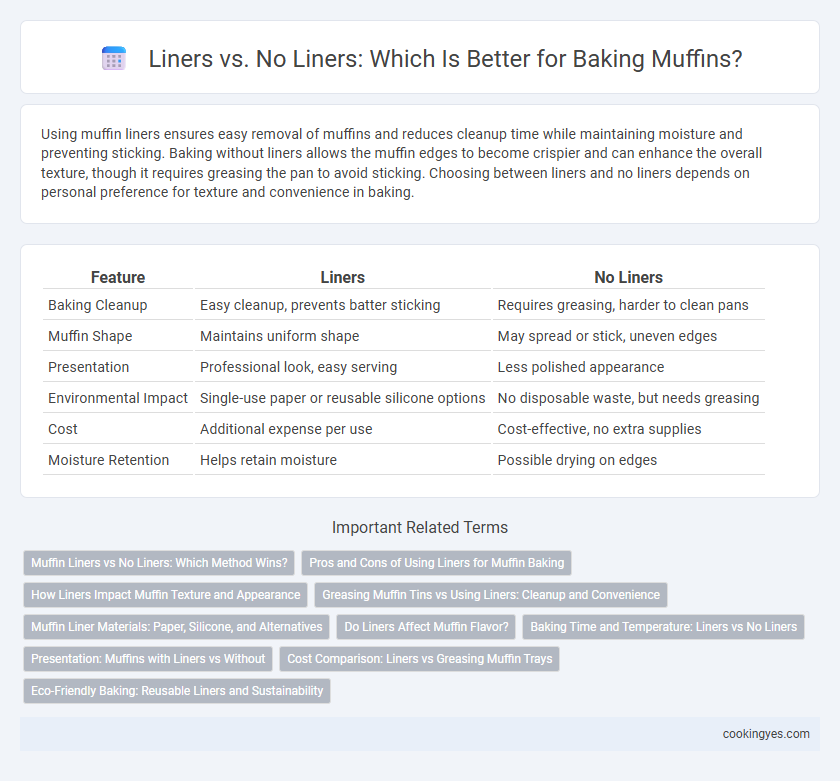Using muffin liners ensures easy removal of muffins and reduces cleanup time while maintaining moisture and preventing sticking. Baking without liners allows the muffin edges to become crispier and can enhance the overall texture, though it requires greasing the pan to avoid sticking. Choosing between liners and no liners depends on personal preference for texture and convenience in baking.
Table of Comparison
| Feature | Liners | No Liners |
|---|---|---|
| Baking Cleanup | Easy cleanup, prevents batter sticking | Requires greasing, harder to clean pans |
| Muffin Shape | Maintains uniform shape | May spread or stick, uneven edges |
| Presentation | Professional look, easy serving | Less polished appearance |
| Environmental Impact | Single-use paper or reusable silicone options | No disposable waste, but needs greasing |
| Cost | Additional expense per use | Cost-effective, no extra supplies |
| Moisture Retention | Helps retain moisture | Possible drying on edges |
Muffin Liners vs No Liners: Which Method Wins?
Muffin liners provide a clean, non-stick surface that preserves the shape and makes cleanup effortless, while baking without liners allows for a crispier crust and direct contact with the pan, enhancing caramelization. Liners minimize the risk of muffins sticking and maintain moisture, ideal for softer textures, whereas no liners require greasing and careful removal, potentially resulting in uneven edges. Choosing between liners and no liners depends on the desired texture, ease of cleanup, and presentation preferences in muffin baking.
Pros and Cons of Using Liners for Muffin Baking
Using liners for muffin baking offers benefits like easy cleanup, preventing muffin sticking, and maintaining moisture, which results in softer texture. However, liners can sometimes cause uneven baking due to restricted heat exposure and may contribute to environmental waste if not chosen as biodegradable options. Baking without liners allows for a crispier crust and better heat distribution but requires greasing the pan and can lead to more challenging cleanup and potential muffin breakage.
How Liners Impact Muffin Texture and Appearance
Using liners in muffin baking creates a more uniform shape and prevents sticking, resulting in a smoother exterior texture and easier removal. Muffin liners help retain moisture, producing a tender crumb with a consistent bake throughout. Without liners, muffins often develop a crisper crust and irregular surface but may require greasing to avoid breakage and sticking.
Greasing Muffin Tins vs Using Liners: Cleanup and Convenience
Using muffin liners significantly reduces cleanup time by preventing batter from sticking to the pan, making it easier to remove muffins without damaging their shape. Greasing muffin tins requires an even coating of butter or oil to prevent sticking, which can sometimes result in uneven texture or difficulty in muffin removal. Liners offer a convenient, mess-free option that also enhances presentation, while greasing requires more effort but allows direct heat contact for a crisper muffin edge.
Muffin Liner Materials: Paper, Silicone, and Alternatives
Muffin liners come in various materials, each offering unique benefits for baking. Paper liners provide convenience and easy cleanup, while silicone liners are reusable, heat-resistant, and eco-friendly. Alternatives such as foil or parchment liners offer durability and non-stick properties, catering to different baking preferences and enhancing muffin presentation.
Do Liners Affect Muffin Flavor?
Muffin liners can subtly influence flavor by retaining moisture and preventing direct contact with the pan, which helps maintain a tender texture and enhances the overall taste experience. Without liners, muffins may develop a slight caramelized crust from direct heat, adding a toasted flavor but risking uneven cooking or sticking that can affect texture negatively. Choosing liners or not ultimately impacts both flavor profiles and convenience during baking and cleanup.
Baking Time and Temperature: Liners vs No Liners
Using liners for muffin baking typically allows for more even heat distribution, resulting in a consistent baking time of around 18-22 minutes at 350degF (175degC). Without liners, muffins may require slightly reduced baking time or a temperature adjustment to prevent over-browning on the edges due to direct contact with the metal pan. Liners also help maintain moisture and reduce the risk of sticking, which can influence the overall texture and bake quality.
Presentation: Muffins with Liners vs Without
Muffins baked with liners maintain a clean, uniform shape and prevent sticking, resulting in a polished and easy-to-serve presentation ideal for gatherings or displays. Without liners, muffins develop a rustic, golden-brown crust that enhances visual appeal but can stick to the pan and create uneven edges. Choosing liners enhances convenience and consistency, while no liners offer a more artisanal, baked-in appearance.
Cost Comparison: Liners vs Greasing Muffin Trays
Muffin liners typically cost between $5 to $10 per pack of 100, offering a convenient, mess-free baking experience that reduces cleanup time. Greasing muffin trays requires purchasing butter or oil, costing roughly $0.05 per use but can result in more time spent cleaning and potential sticking issues. Choosing liners balances upfront cost with ease and cleanliness, while greasing trays offers lower material costs but higher labor and maintenance.
Eco-Friendly Baking: Reusable Liners and Sustainability
Choosing reusable muffin liners significantly reduces waste compared to disposable paper liners, promoting eco-friendly baking practices. Silicone or stainless steel liners offer durability and easy cleaning, making them sustainable options that minimize landfill contributions. Using these sustainable baking accessories supports a zero-waste lifestyle while maintaining muffin quality and convenience.
Liners vs no liners for muffin baking Infographic

 cookingyes.com
cookingyes.com